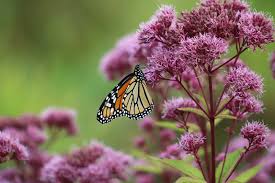Joe Pye Weed Plant, The Joe Pye weed plant (Eutrochium spp.) is a standout perennial native to North America, known for its towering height, clusters of fragrant flowers, and importance to pollinators. This versatile plant has become a favorite among gardeners and environmentalists for both its beauty and ecological benefits. Whether used as a striking garden feature or in wildlife habitats, Joe Pye weed adds color, structure, and life to any landscape.
Description and Varieties
Joe Pye weed belongs to the Asteraceae family, featuring varieties such as Eutrochium purpureum (sweet Joe Pye weed), Eutrochium maculatum (spotted Joe Pye weed), and Eutrochium dubium (coastal Joe Pye weed). While the species can differ slightly in habitat preference and leaf patterns, all are characterized by clusters of tiny, tubular, pink to lavender flowers that bloom in late summer to fall.
This plant can reach heights of 4 to 7 feet (1.2 to 2.1 meters), with some species growing even taller. It thrives in moist soils, making it ideal for rain gardens, stream banks, or low-lying areas. The flowers attract pollinators, including bees, butterflies, and moths, making the Joe Pye weed plant a critical player in the ecosystem.
Growing and Care
Joe Pye weed plants are hardy in USDA zones 4 to 9, meaning they can withstand various climates, from cool northern regions to warmer southern zones. These plants prefer full sun to partial shade and do best in consistently moist, well-draining soil. However, they are resilient and can tolerate periods of drought once established.
Here are some key care tips for growing Joe Pye weed successfully:
- Planting: Early spring or fall is the best time to plant. Space the plants about 2 to 3 feet apart to allow room for their substantial growth.
- Watering: Although drought-tolerant, regular watering encourages lush growth, especially during dry spells.
- Fertilization: Joe Pye weed generally doesn’t need much fertilizer. If the soil is poor, adding compost in the spring can give it a boost.
- Pruning: Cut back the stems to the ground after flowering in the fall to promote healthy growth the following season.
Ecological Benefits
The Joe Pye weed plant is a magnet for pollinators. The nectar-rich flowers attract various insects, especially butterflies like the monarch and swallowtail, as well as honeybees and native bees. In addition to pollinators, birds feed on its seeds in the fall, making this plant essential for maintaining biodiversity.
By adding Joe Pye weed to your garden, you create a habitat-friendly space that supports the food web, contributing to pollinator conservation efforts. Moreover, the plant’s deep roots help prevent soil erosion, stabilizing slopes and riverbanks.
Landscaping Ideas
Thanks to its height and bold flower clusters, Joe Pye weed works well as a background plant in flower beds or along fences. It also adds vertical interest when paired with shorter plants such as coneflowers, black-eyed Susans, or hostas. Given its moisture-loving nature, it’s an excellent addition to rain gardens or alongside ponds and streams.
If you’re looking to create a pollinator-friendly garden, planting Joe Pye weed alongside other native perennials such as milkweed, ironweed, and blazing star will ensure that bees and butterflies have food throughout the growing season.
Folklore and Medicinal Uses
The Joe Pye weed plant has an interesting backstory. According to legend, the plant was named after a Native American healer, Joe Pye, who used the plant to treat fevers and other ailments. Traditionally, parts of the plant were used to make teas thought to relieve cold symptoms, aid digestion, and promote urinary health.
Though Joe Pye weed is not widely used in modern herbal medicine, it remains a part of folk traditions. However, it’s essential to consult with a healthcare provider before using any wild plant medicinally.
Conclusion
The Joe Pye weed plant is more than just a towering beauty in the garden—it’s a symbol of ecological balance. Its showy blooms, low-maintenance nature, and ability to attract pollinators make it a valuable addition to any landscape. Whether you are looking to create a pollinator-friendly garden, prevent soil erosion, or simply enjoy its beauty, Joe Pye weed will not disappoint.
With its rich history, environmental benefits, and easy care, this native plant proves that sometimes the wild, untamed elements of nature bring the most charm and value to our cultivated spaces.
You Might Also Like These:



